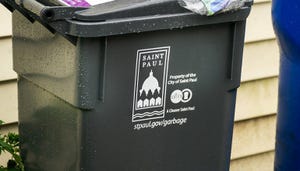The Road to Recovery
Developing a well-functioning MRF takes extensive planning and analysis.
December 1, 2010
Pete Keller, Mark Henke, Eric Shuck and Terry Schneider
Getting a materials recovery facility (MRF) up and running is not for the faint of heart. Extensive planning and effort are necessary to design, build and operate a MRF.
Long before the first plastic bottle is sorted, a myriad of actions must take place to ensure that the facility is in the correct location and is equipped with the appropriate processing equipment. A well-designed MRF leads to a better operating MRF. This, in turn, leads to enhanced recycling opportunities for communities and more items kept within the “closed manufacturing loop,” a key to sustainability.
Location and Market

NEEDED SUPPORT: For a MRF to succeed, public policy supporting recycling must exist in the surrounding community.
Three dynamics need to be in place in the communities that a MRF will serve. First, public policy must exist to support recycling programs. Secondly, the public itself must embrace recycling. Third, there must be access to end markets (domestic and export) for the recyclable materials. End markets must be identified during the planning process to ensure outlets for the recovered materials.
A MRF needs to be designed to take in and process the types of materials that are available within the local market. Therefore, an analysis of the area’s waste stream is a key step. Furthermore, regular audits must take place to monitor changes in waste composition. The waste stream will be impacted by changes in customer behavior and service offerings as well as any legislative activities affecting the waste stream or collection methods. Different commodity mixes can have a drastic impact on daily operations, the type of processing equipment needed, the revenue a MRF is able to draw in and ultimately the return on investment.
The facility must be able to safely and efficiently accommodate inbound collection vehicles. These may range from standard route collection vehicles to 53-foot walking floor trailers coming from a transfer station. These vehicle variances affect the space required for the tipping floor, the placement of the scales, traffic flow and the overall size of the facility.
Design/Siting
The types of permits required for a MRF are dependent on jurisdiction and state. Assuming zoning is appropriate, a minimum of a development (building) permit is necessary. Additionally, some states require an evaluation of environmental consequences before approving or denying a MRF proposal. Others require a full-blown solid waste facility permit. In highly sensitive areas, air permits may be required because of concerns with dust and odors.
The site also needs to have compatible contiguous uses (schools or residential areas pose unique traffic and pedestrian challenges), access to arterial (or larger) roads, ample truck queuing and sufficient access to interstate highways, rail or shipping yards for the transport of recovered materials to end markets.
Like any other investment, you must have the volume required to generate a sufficient return. A highly automated MRF will require more up-front capital but will reduce costs, improve recovery and increase the speed of operations in the long-term. Some small-volume MRFs may find it hard to offset the upfront cost with labor savings alone. When evaluating individual recovery components, such as an optical sorting unit for plastic, first understand the volume available in the waste stream in order to determine if the potential revenue merits investment in the unit. Then evaluate what potential labor savings you will experience with the addition of the equipment and if the equipment can capture more volume than traditional manual sorting. Another point to evaluate is through-put: with additional components or added technology, will the through-put (tons processed per hour) be enhanced enough to justify the additional cost?
The type of recovery equipment is determined by several contributing factors including the type of material to be processed, such as residential material, commercial material or a combination of the two. Other considerations are the desired through-put, total volume of material per month, material characteristics and the desired level of automation.
As MRFs become increasingly complex, your maintenance staff must become more skilled. No longer is maintenance only required to maintain standard conveyors, motors and the like. Now maintenance is required to troubleshoot main system computers, optical sorting units and the ever-evolving technology in base sorting equipment. You must ensure that your maintenance staff is equipped with the proper tools and training to be successful.
This is critical when first starting a MRF operation and can be accomplished by working closely with the original equipment manufacturer to determine proper preventive maintenance schedules, wear life and troubleshooting procedures. If not managed from day one, all of these variables can have an immediate impact on your operating cost per ton.
Equipment Procurement

KEEPING A CLOSE EYE: MRF owners need to conduct regular audits of the area waste stream to monitor changes in waste composition.
There are several major manufacturers of MRF equipment. Much of the specification is driven by the characteristics of the in-bound material and what the MRF is trying to produce for sale to end markets. That largely dictates what components will make up system design. Decisions to select certain manufacturers are based on their experience, efficiency, service, technology, compatibility, processing guarantees, product warranty, relationships and, yes, price.
The first step is to outline the minimum requirements of the project and the expected recovery system components. Also consider projected through-put, level of desired automation, material characteristics, available footprint, expected flow of material, traffic flow, etc.
Some factors to consider when selecting equipment include:
Safety components such as ingress and egress points, continuous accessibility for the sorting staff and OSHA compliant features.
Operating costs of the system.
Projected maintenance costs of the system and its accessibility for maintenance.
The warranty and system performance guarantee.
The labor needed to operate the system.
How well the equipment design fits the building footprint and complements the inbound/outbound traffic flow.
How easily future components could be added with minimal downtime and installation costs.
Benefit and timing of future components for enhanced recovery or capacity
Installation timeframe
Construction Schedule
The permitting process is the driver. If a shell (building) already exists, assume it will take about five to six months from the final design approval to have the equipment built and delivered. Assume it will take another one to three months to install and test the equipment, depending on system complexity. Never assume that the system will be producing quality outbound materials at budgeted quantities on the first day of operations. Expect that it will take another month of processing to “dial in” the components to achieve optimal recovery.
Pay Back
Many local communities support recycling, and a MRF is a necessary component of sustainability, but the time to recoup the investment in a MRF is almost entirely at the mercy of the commodity markets. If you have a location in the right markets at the right time, you could see a return in three years or less. Unfortunately, some locations may not return their investment before they need replacing.
No one builds a MRF just for fun. It’s an expensive venture that must fulfill a need and payback the investment. Time, investigation and a thorough analysis of all pertinent factors are mandatory to meeting those goals.
Pete Keller is the area president of Republic Services' Northwest Area. Mark Henke is the manager of operational support — recycling for Republic. Erik Schuck is the general manager of Allied Waste Services of the Twin Cities. Terry Schneider is director of rail development and logistics for Republic.
You May Also Like


